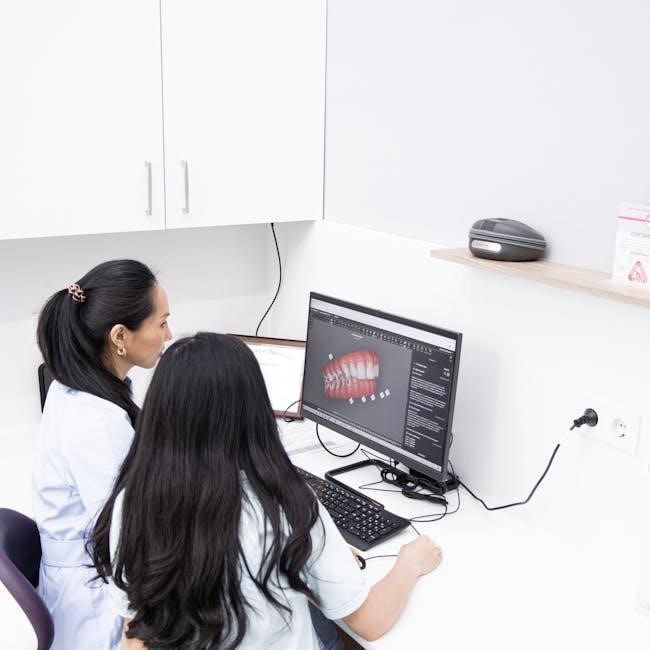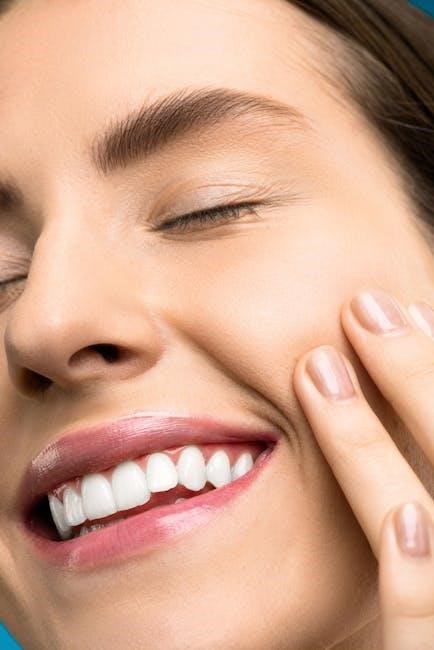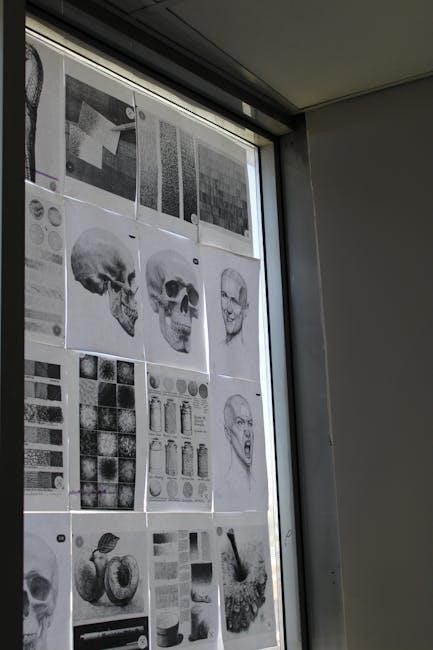The Tooth Meridian Chart, rooted in Traditional Chinese Medicine, illustrates the connection between teeth and body meridians. It shows how each tooth corresponds to specific organs, glands, and emotional states, aiding in holistic health diagnostics and prevention.
Overview of Traditional Chinese Medicine (TCM)
Traditional Chinese Medicine (TCM) is an ancient holistic healing system that emphasizes the interconnectedness of the body, mind, and spirit. Rooted in the philosophy of Yin-Yang and the flow of Qi (life energy), TCM seeks to restore balance and harmony within the body. It views health as a state of equilibrium among physical, emotional, and spiritual forces. TCM practices, such as acupuncture, herbal medicine, and Qigong, aim to regulate the flow of Qi through meridians, or energy pathways, that connect various organs and systems.
Central to TCM is the concept of Zang-Fu organs, which represent functional systems rather than anatomical structures. These organs are linked through meridians, creating a network that influences overall well-being. TCM also recognizes the role of emotions in health, as each organ is associated with specific emotional states. This holistic approach allows TCM to address both physical and emotional root causes of illness, making it a comprehensive system for prevention and treatment.
TCM has been used for centuries to diagnose and treat a wide range of conditions, from pain and inflammation to chronic diseases. Its principles form the foundation of the Tooth Meridian Chart, which maps the connections between teeth, organs, and energy pathways. By understanding these relationships, TCM offers a unique perspective on oral health and its impact on overall wellness.
The Connection Between Teeth and Organs
The Tooth Meridian Chart reveals a profound connection between teeth and various organs in the body. According to Traditional Chinese Medicine (TCM), each tooth is linked to specific organs, glands, and energy pathways, or meridians. This interconnectedness means that issues in the mouth can influence distant organs, and vice versa. For example, problems with molars may affect the stomach or large intestine, while incisors are connected to the kidneys and adrenal glands.
The chart maps these relationships, showing how energy flows through the body. For instance, the upper teeth are often linked to the upper body, including the heart, lungs, and sinuses, while the lower teeth connect to the lower body, such as the liver, pancreas, and intestines. This holistic view emphasizes that oral health is not isolated but deeply intertwined with overall well-being. Understanding these connections can help address root causes of health issues and promote balanced wellness.
The Science Behind Meridians
Meridians are conceptual energy pathways in the body, central to Traditional Chinese Medicine (TCM). They are believed to channel life energy, or qi, connecting internal organs, glands, and external bodily structures, including teeth. While not physically visible, meridians are thought to regulate the flow of energy and maintain health balance. Modern studies suggest that meridians may correspond to observable anatomical structures, such as nerve pathways or fascia, which could explain their functional significance.
Research using advanced imaging techniques, like MRI, has identified correlations between meridian pathways and physical structures, such as blood vessels and lymphatic systems. This has led some scientists to propose that meridians represent complex networks of interconnected tissues. The Tooth Meridian Chart aligns with this idea, mapping teeth to organs via shared meridians. For example, the stomach and large intestine meridians are linked to molars, while the heart meridian connects to upper incisors.
While the concept of meridians remains debated, their practical applications in diagnostics and therapy are widely recognized. They offer a holistic framework for understanding health, emphasizing the interplay between local and systemic well-being. This approach is central to the Tooth Meridian Chart’s purpose.

The Role of Meridians in Oral Health
Meridians play a vital role in oral health by connecting the mouth to the body’s energy network. According to Traditional Chinese Medicine (TCM), meridians channel life energy, or qi, linking teeth to organs, glands, and tissues. This interconnected system allows for the diagnosis and treatment of oral health issues by addressing their systemic roots.
The Tooth Meridian Chart highlights how each tooth corresponds to specific meridians, influencing organs like the stomach, liver, and heart. For example, the stomach meridian is linked to the lower front teeth, while the large intestine meridian connects to molars. Disruptions in these pathways can lead to dental problems like gum disease or toothaches, as well as systemic illnesses.
Understanding meridians in oral health emphasizes the importance of holistic care. By addressing energy imbalances, practitioners can prevent issues before they arise. This approach aligns with the Tooth Meridian Chart’s purpose, offering a comprehensive view of how oral health reflects and affects overall well-being.

Meridian Tooth Chart: What It Is
A Meridian Tooth Chart is a visual guide mapping the connections between teeth and body meridians, glands, organs, and emotions. It illustrates how each tooth corresponds to specific energy pathways, aiding in understanding the mouth-body connection and promoting holistic health diagnostics.
6.1 How to Read the Meridian Tooth Chart
Reading the Meridian Tooth Chart involves understanding the visual connections between teeth, meridians, and corresponding organs or emotions. Each tooth is mapped to specific energy pathways, or meridians, which flow through the body. The chart typically lists the tooth number, its location (upper or lower jaw), and the associated meridian. For example, the upper right incisors may connect to the Lung meridian, while the lower molars might link to the Large Intestine meridian. By identifying the affected tooth, users can trace its meridian pathway to understand potential imbalances in related organs or emotional states. This tool is designed to help practitioners and individuals alike identify underlying health issues through dental symptoms, promoting a holistic approach to wellness. The chart also highlights how emotional stress, such as anxiety or grief, can manifest in specific teeth, offering a bridge between physical and emotional health. Regular reference to the chart can enhance preventive care and guide targeted treatments.

Emotional and Spiritual Connections
The Tooth Meridian Chart also reveals profound emotional and spiritual connections linked to dental health. According to Traditional Chinese Medicine, each tooth is associated with specific emotional states and energy pathways. For instance, the upper incisors are often connected to self-expression and confidence, while the molars may reflect patterns of stress, anxiety, or unresolved grief. This holistic perspective suggests that emotional imbalances can manifest physically in the mouth, affecting tooth health and overall well-being. By addressing these emotional and spiritual roots, individuals can achieve deeper healing and balance. The chart serves as a valuable tool for understanding how personal experiences and emotions influence physical health, fostering a more integrated approach to wellness. This connection between the mouth and mind highlights the importance of emotional awareness in maintaining healthy teeth and a harmonious body-energy flow.
Teeth and Organ Relationships
The Tooth Meridian Chart outlines specific relationships between individual teeth and internal organs, highlighting how dental health can influence overall bodily functions. For example, the upper incisors are linked to the heart and lungs, while the lower molars connect to the large intestine and stomach. This interconnectedness is rooted in Traditional Chinese Medicine, where energy pathways, or meridians, flow through the body, connecting organs to specific teeth. When a tooth is compromised due to decay, infection, or extraction, it can disrupt the flow of energy, potentially leading to issues in the corresponding organ. Conversely, problems in organs like the liver or kidneys may manifest as dental issues, such as gum disease or tooth pain. Understanding these relationships allows for a more holistic approach to health, where addressing dental problems can also support organ wellness. This interconnected system emphasizes the importance of maintaining oral health to preserve overall bodily harmony.

Upper Teeth Connections
The upper teeth, according to the Tooth Meridian Chart, are closely linked to various vital organs and systems in the body. Each tooth in the upper jaw corresponds to specific meridians, which are energy pathways connecting the mouth to internal organs. For instance, the upper incisors are associated with the heart and lungs, while the upper molars connect to the stomach, pancreas, and large intestine. This relationship highlights how oral health can influence digestive and respiratory functions. The upper canines, meanwhile, are linked to the liver and gallbladder, emphasizing their role in detoxification and energy flow. Additionally, the upper teeth are connected to the endocrine system, particularly the adrenal glands, which regulate stress hormones. Understanding these connections can help identify underlying health issues, as tooth problems may reflect organ imbalances. For example, recurring issues with an upper molar could signal stomach or intestinal distress. This holistic perspective underscores the importance of maintaining upper tooth health to support overall bodily well-being.
Lower Teeth Connections
The lower teeth, as outlined in the Tooth Meridian Chart, have distinct connections to various organs and systems within the body. Each lower tooth is linked to specific meridians, creating a network that influences overall health. For example, the lower incisors are associated with the small intestine, while the lower molars connect to the kidneys and adrenal glands. This relationship suggests that issues with lower teeth may reflect problems in these organs. The lower premolars are linked to the liver and gallbladder, emphasizing their role in detoxification and energy balance. Additionally, the lower canines are connected to the Triple Warmer meridian, which governs the body’s temperature and metabolic processes. Understanding these connections can provide insights into systemic health challenges. For instance, chronic pain in a lower molar might indicate kidney dysfunction or adrenal fatigue. By addressing oral health, individuals can potentially improve the functioning of these connected organs. This interconnectedness highlights the importance of holistic care in maintaining both dental and bodily well-being.
Specific Teeth and Their Associated Organs
The Tooth Meridian Chart provides a detailed mapping of each tooth to specific organs and systems in the body. For instance, the upper incisors are linked to the lungs, while the upper molars connect to the stomach and pancreas. Lower incisors are associated with the small intestine, and lower molars correspond to the kidneys and adrenal glands. This precise relationship highlights how dental health can influence organ function. The lower premolars, for example, are connected to the liver and gallbladder, emphasizing their role in detoxification processes. Similarly, the lower canines are tied to the Triple Warmer meridian, which regulates metabolism and energy distribution. Understanding these connections can help identify underlying health issues, as tooth pain or decay may signal problems in related organs. For example, persistent issues with a lower molar could indicate kidney strain or adrenal imbalance. This relationship underscores the importance of addressing oral health as part of overall wellness. By recognizing these associations, individuals can take a more holistic approach to maintaining their health.
Practical Applications
The Tooth Meridian Chart offers practical tools for diagnostics, prevention, and holistic treatment. It helps identify underlying organ issues through tooth symptoms, enabling early intervention. Dentists and practitioners use it to create personalized treatment plans, addressing both oral and systemic health. Regular monitoring with the chart can prevent diseases by highlighting risks early, promoting a proactive approach to wellness. Additionally, it bridges dental and alternative therapies, fostering a comprehensive healthcare strategy. This integrative method supports overall well-being and enhances the effectiveness of treatments, making it a valuable resource for modern and traditional medicine alike. By focusing on connections between teeth and organs, the chart aids in understanding the body’s interconnected systems, encouraging a more balanced and informed lifestyle. Its applications extend beyond dentistry, offering insights for general health maintenance and emotional well-being. Using the Tooth Meridian Chart, individuals can adopt targeted strategies to improve their quality of life, ensuring long-term health through awareness and prevention. It serves as a versatile tool for anyone seeking to understand and manage their health holistically, providing clear guidelines and actionable steps.
12.1 Dental Health Implications
The Tooth Meridian Chart highlights the profound impact of dental health on overall well-being. By mapping teeth to organs and systems, it reveals how issues like decay or gum disease can resonate beyond the mouth. For instance, problems in the upper molars may affect the stomach or liver, while lower incisors could influence the kidneys. This connection emphasizes the importance of addressing dental issues promptly to prevent systemic complications. The chart also underscores the role of emotions in oral health, such as stress-related grinding that may strain the jaw and align with meridian pathways. Understanding these links encourages a proactive approach to dental care, including regular check-ups and holistic treatments. By bridging the gap between teeth and organs, the chart offers a comprehensive view of health, enabling individuals to prioritize preventive measures and maintain balance in their body’s interconnected systems. This knowledge empowers patients to take charge of their dental and overall health, fostering long-term wellness and vitality.
12.2 Diagnostics with the Meridian Chart
The Tooth Meridian Chart serves as a valuable diagnostic tool, enabling practitioners to trace symptoms back to specific teeth and their corresponding organs. By identifying affected teeth, professionals can pinpoint related meridian pathways and associated organs, aiding in the early detection of systemic issues. For example, if a patient experiences stomach discomfort, the chart may reveal a connection to the upper molars, which are linked to the digestive system. This holistic approach allows for targeted treatments that address both dental and organ-related problems simultaneously. The chart also helps identify emotional and stress-related factors that may contribute to oral health issues, such as grinding teeth linked to anxiety or stress. By analyzing these connections, practitioners can develop comprehensive treatment plans that promote overall well-being. This integrative diagnostic method bridges the gap between dental care and general health, offering a unique perspective on how the body functions as a unified system. It empowers both professionals and patients to adopt a more proactive and holistic approach to health management.
12.3 Emotional and Stress Factors
Emotional and stress factors play a significant role in oral health, as revealed by the Tooth Meridian Chart. Stress can manifest physically, often affecting specific teeth and their corresponding meridians. For instance, anxiety or tension may lead to grinding or clenching, which can strain the jaw and impact related organs. The chart highlights how emotional states, such as fear or anger, are linked to particular teeth and organs, creating a mind-body connection. Understanding these links can help individuals address emotional imbalances that might contribute to dental issues. For example, stress-related teeth grinding may indicate underlying anxiety, which, if unresolved, could affect the stomach or large intestine, organs connected to certain teeth. By recognizing these patterns, individuals can adopt stress management techniques to improve both emotional and dental health. This holistic approach emphasizes the importance of addressing emotional well-being as part of maintaining overall wellness, bridging the gap between mental health and physical symptoms. The Tooth Meridian Chart thus serves as a powerful tool for identifying and managing stress-related oral health challenges.
12.4 Using the Chart for Prevention
The Tooth Meridian Chart is a valuable tool for preventive care, allowing individuals to identify potential health issues before they escalate. By understanding the connections between teeth and organs, one can proactively address vulnerabilities. For instance, if a specific tooth is linked to the stomach meridian, signs of dental distress in that area might indicate digestive imbalances. This early detection enables targeted interventions, such as dietary adjustments or stress reduction techniques, to prevent more severe problems. Additionally, the chart encourages holistic practices like acupuncture or herbal remedies to maintain balance. Regular monitoring of oral health using the chart can also help prevent conditions like gum disease or tooth decay by highlighting areas needing extra attention. By fostering awareness of these interconnections, the Tooth Meridian Chart empowers individuals to take a proactive approach to their health, reducing the risk of chronic issues and promoting overall wellness. This preventive framework aligns seamlessly with the principles of Traditional Chinese Medicine, emphasizing harmony and balance in the body.

Steps to Use the Meridian Chart
Using the Tooth Meridian Chart involves a systematic approach to understanding the interconnectedness of oral health and overall wellness. Begin by identifying the specific tooth or area of concern. Locate its corresponding meridian and associated organs using the chart. This step helps pinpoint potential imbalances or vulnerabilities in the body. Next, analyze the emotional and spiritual connections linked to the tooth, as stress or emotional states can influence physical health. Based on this information, consider dietary adjustments, stress management techniques, or holistic practices like acupuncture to restore balance. Regularly monitoring changes in oral health and cross-referencing them with the chart can lead to early detection of issues. Consulting with a healthcare professional is recommended for persistent or severe concerns. By following these steps, individuals can harness the chart’s insights to promote preventive care and maintain harmony between the mouth and body. This approach aligns with the principles of Traditional Chinese Medicine, emphasizing proactive health management.
Case Studies and Examples
Several case studies demonstrate the practical application of the Tooth Meridian Chart. For instance, a patient with recurring digestive issues was found to have cavities in their upper molars, which correspond to the stomach and large intestine meridians. Addressing these dental issues through fillings and improved oral hygiene led to significant relief from digestive symptoms. Another case involved a patient experiencing lower back pain, which was linked to their lower molars connecting to the sacro-iliac joints. Treating the tooth decay and incorporating stress-reduction techniques alleviated both dental discomfort and back pain. Additionally, a patient with emotional stress related to financial instability reported gum inflammation around their incisors, which are associated with the kidney meridian and emotional stability. By addressing the emotional root cause and improving dental care, the gum health improved. These examples highlight how the chart bridges oral health with systemic wellness, offering a holistic approach to diagnosis and treatment.

Available Resources
The Tooth Meridian Chart is widely available as a downloadable PDF, offering a visual guide to understanding the connections between teeth and organs. It can be found on platforms like dailyhealthpost.com and dailyprintablegraphics, providing an accessible tool for holistic health tracking.
15.1 Downloading the PDF
Downloading the Tooth Meridian Chart in PDF format is a convenient way to access this valuable resource. Websites such as dailyhealthpost.com and dailyprintablegraphics offer downloadable versions of the chart. These PDFs are designed to be user-friendly, providing a clear and interactive guide to understanding the connections between teeth and organs.
The PDF chart is often printable, making it easy to use as a quick reference guide for personal or professional purposes. Many versions include detailed mappings of each tooth to its corresponding organs, glands, and emotional states. This makes it a powerful tool for holistic health practitioners and individuals alike.
To download the PDF, simply visit the website, search for the Tooth Meridian Chart, and follow the download instructions. Some versions may require signing up for a newsletter or creating an account, while others are available for immediate download. Once downloaded, the chart can be saved to your device or printed for easy access.
This resource is ideal for anyone interested in exploring the link between oral health and overall wellness, offering a visually appealing and informative guide to the tooth meridian system.
The Tooth Meridian Chart offers a fascinating insight into the interconnectedness of oral health and overall wellness. By mapping each tooth to corresponding organs, glands, and emotional states, it provides a holistic approach to understanding and managing health. This chart, deeply rooted in Traditional Chinese Medicine, highlights how issues in the mouth can influence other parts of the body and vice versa.
For practitioners and individuals alike, the Tooth Meridian Chart serves as a valuable diagnostic and preventive tool. It encourages a deeper appreciation for the body’s intricate systems and the importance of maintaining balance. Whether for personal use or professional practice, this chart underscores the importance of addressing oral health as part of a broader strategy for well-being.
By exploring and utilizing the Tooth Meridian Chart, individuals can gain a new perspective on their health, fostering a more integrated approach to care. Downloading the PDF version ensures easy access to this powerful resource, helping to bridge the gap between dental and holistic health practices.
Frequently Asked Questions (FAQs)
What is a Tooth Meridian Chart?
A Tooth Meridian Chart is a visual guide that maps the connections between teeth, organs, glands, and emotional states, based on principles from Traditional Chinese Medicine.
How accurate is the chart?
While rooted in TCM, its accuracy varies. It is widely used as a diagnostic and preventive tool but should complement, not replace, professional medical advice.
Can I use the chart for self-diagnosis?
Yes, but with caution. It can help identify potential links between oral and overall health, but professional consultation is recommended for accurate diagnosis.
Where can I download the chart?
The Tooth Meridian Chart is available as a PDF online. Websites like Daily Health Post and printable graphics platforms offer free downloads for personal or professional use.
Is the chart useful for children?
Yes. It can help track dental development and health in children, offering insights into their overall wellness through oral health monitoring.
Does the chart cover emotional connections?
Yes. It links teeth to emotional states, suggesting that stress or emotional turmoil may influence oral health and vice versa.
Is the chart scientifically validated?
While widely used, it is not scientifically validated in Western medicine. It is best viewed as a complementary tool for holistic health practices.
Can it prevent health issues?
Yes. By identifying connections, it can help prevent health problems by addressing oral health early and promoting overall wellness.
Is it suitable for dental professionals?
Absolutely. It provides a holistic perspective, aiding dentists in understanding the broader health implications of oral conditions.
How do I interpret the chart?
Each tooth is linked to specific organs and emotions. For example, molars connect to the stomach and large intestine, while incisors relate to the kidneys;
Can I print the chart?
Yes. Downloading the PDF allows you to print it for easy reference, making it a practical tool for both personal and professional use.
Does the chart cover both upper and lower teeth?
Yes. It distinguishes between upper and lower teeth, as each has unique connections to different organs and systems in the body.
Is the chart useful for stress management?
Yes. By identifying emotional links, it can help address stress-related oral issues, promoting mental and physical well-being.
Can it help with pain diagnosis?
Yes. It can provide insights into the source of pain by linking it to related organs or systems, aiding in targeted treatment.
Does the chart include case studies?
Yes. Many resources include case studies demonstrating how the chart has been used to improve health outcomes through holistic approaches.
Is the chart free to download?
Yes. Most versions of the Tooth Meridian Chart are available for free as PDF downloads, making it accessible to everyone.
Can it be used for pets?
While primarily designed for humans, some practitioners adapt it for pets, though this is less common and should be done with professional guidance.
Does the chart cover all teeth?
Yes. It includes all teeth, from wisdom teeth to permanent and baby teeth, providing a comprehensive view of oral and overall health connections.
Is the chart updated regularly?
Yes. New research and findings often lead to updates, ensuring the chart remains a relevant and effective tool for health and wellness.
Can it help with nutrition planning?
Yes. By identifying organ connections, it can guide dietary choices to support both oral and overall health.
Does the chart work for everyone?
While beneficial for many, individual results may vary. It is most effective when used alongside other health practices and professional advice.
Can it be used in schools?
Yes. It can serve as an educational tool to teach students about the importance of oral health and its connection to overall wellness.
Does the chart include visual aids?
Yes. Most versions include detailed diagrams and charts, making it easy to understand and apply the information.
Can it help with sleep issues?
Yes. By addressing oral health and related organs, it may provide insights into sleep disorders and ways to improve sleep quality.
Does the chart cover dental anatomy?
Yes. It includes detailed information about tooth structure and its relation to meridians, offering a comprehensive understanding of oral health.
Can it be used for meditation practices?
Yes. Its focus on emotional and energy connections makes it a useful tool for mindfulness and meditation practices aimed at balancing the body’s energy.
Does the chart include historical background?
Yes. Many versions provide historical context, tracing the chart’s origins in Traditional Chinese Medicine and its evolution over time.
Can it help with weight management?
Yes. By linking teeth to organs like the stomach and pancreas, it can offer insights into digestion and metabolism, aiding in weight management strategies.
Does the chart cover allergies?
Yes. It can help identify potential allergic reactions by linking teeth to organs involved in immune responses, such as the lungs and large intestine.
Can it help with skin health?
Yes. By addressing connections to organs like the liver and gallbladder, it can provide insights into skin health and conditions like acne or eczema.
Does the chart include information on detoxification?
Yes. It links teeth to organs involved in detox processes, such as the liver and kidneys, offering a holistic approach to cleansing the body.
Can it help with hormonal balance?
Yes. By connecting teeth to endocrine glands, it can provide insights into hormonal imbalances and ways to restore balance naturally.
Does the chart cover mental health?
Yes. It explores the emotional and mental connections linked to teeth, offering a pathway to address stress, anxiety, and other mental health issues.
Can it be used for energy healing?
Yes. The chart’s focus on meridians and energy flow makes it a popular tool for energy healing practices aimed at restoring balance to the body.
Does the chart include information on acupuncture points?
Yes. It often includes acupuncture points related to teeth and organs, providing a comprehensive guide for energy healing and pain relief.
Can it help with chronic pain management?
Yes. By identifying connections between teeth and pain-prone areas, it can aid in developing targeted strategies for managing chronic pain.
Does the chart cover oral hygiene tips?
Yes. Many versions include tips for maintaining oral health, such as brushing techniques and dietary advice, to support overall wellness.
Can it help with bad breath?
Yes. By addressing connections to organs like the stomach and intestines, it can provide insights into the root causes of bad breath and ways to eliminate it.
Does the chart include information on fluoride?
Yes. It often discusses the role of fluoride in oral health and its potential impact on overall wellness, offering a balanced perspective.
Can it help with gum disease?
Yes. By linking gums to organs like the pancreas and stomach, it can provide insights into the root causes of gum disease and ways to treat it holistically.
Does the chart cover dental implants?
Yes. It includes



